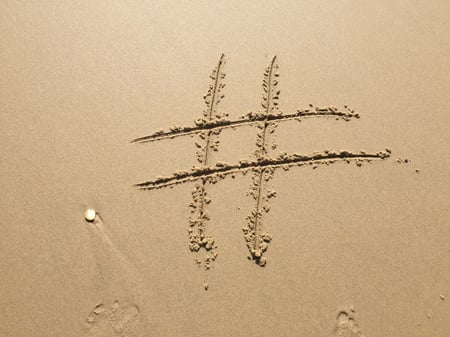Hashtags: why use them for business purposes and how do you make them?

As of 2023, hashtags are a well-known phenomenon in the online world. What started as a specific attribute of Twitter has now become commonplace on all social media platforms, from Instagram to LinkedIn. That means that hashtags also offer plenty of opportunities and possibilities in a business context. But how did hashtags arise, and why do we actually use them? In this blog article, you will learn everything about the phenomenon of hashtags, and I provide four examples of how you can use hashtags in a business context.
How did the hashtag start?
In october 2007 the hashtag was officially used for the first time. This happened during the forest fires in California by the American Nate Ritter. The hashtags were used to keep people up to date about the fires. But only during the Iranian protest in 2009 the value of the hashtag became evident. By adding hashtags to social media messages, people around the world were able to follow the events.
Twitter realized that the hashtag was a good addition to tweets. Therefore, on the 1st of july 2009, hyperlinks were automatically inserted when using hashtags. From that moment on, people could see which topics were popular online.
Until today, people still use hashtags for big news events. However, today, the hashtag has become much more than that. It has become a method to label social media messages and categorize them by topic, so that the message becomes more loaded (similar to emoticons). Certain hashtags have even grown into global phenomena, such as #metoo.
How do you make a hashtag?
You start a hashtag with a 'bracket' (#) followed by a fitting keyword without spaces in between, such as #inboundmarketing or #remotesales for example.
As a user, you are free to make any hashtag you like. The only thing you have to is type a #-sign followed by a keyword in your social media message. But think twice before using a keyword. A hashtag is not just a nice word that you add to your message. It has to be a thought through keyword or passage that other social media users will understand directly. This way, you are more likely to inspire people to use the hashtag as well as follow it. A good hashtag created an online community.
Bu pay attention: you cannot use certain letters and tokens in hashtags. If, for example, all tokens in a hashtag consist of numbers such as #1234, it does not work. Use a maximum of two to three hashtags per post. Here, you can read more about hashtag etiquette.
4 ways to use hashtags for business purposes
Today, hashtags are no longer only meant for consumers and B2C companies. The principle also became widespread in a business context, especially now that you can use LinkedIn hashtags. Below I list four ways that you can use hashtags for your organization:
1. Become noticed by your target group
An important objective of hashtags is to filter social media messages. As a social media user, you can follow certain hashtags so that you will see messages about a particular topic appear on your feed. This is a good opportunity for your organization to become noticed by your target group. Research which hashtags your target groups finds interesting and share content that aligns with that. This way, you can reach a new group of people outside your usual network.
2. Give your brand meaning
Hashtags also offer opportunities for branding. For example, you can launch your own hashtag as a pay-off for your brand. If you do this well, your pay-off can even become a hashtag that is commonly used by your followers. For example, think of Nike's #justdoit.
3. Create interaction surrounding an event or topic
Are you organizing a webinar, a (virtual) event or are you going to present at a fair? Make sure that the audience starts talking about your cause by connecting a specific hashtag to it. This way, visitors from big events for example can meet each other online and start conversations with each other. This only works if you clearly communicate the intention behind the hashtag, interact with the community and promote it actively. This starts by sharing your own content and connecting it to the hashtag.
4. Social monitoring and social listening
Hashtags are also handy tools to monitor social media messages. With good social tools you can make a feed of messages in which your (branded) hashtags are mentioned. You can also obtain insights about your target group with the help of social listening. For example, you can follow hashtags that are relevant to your area of expertise.

